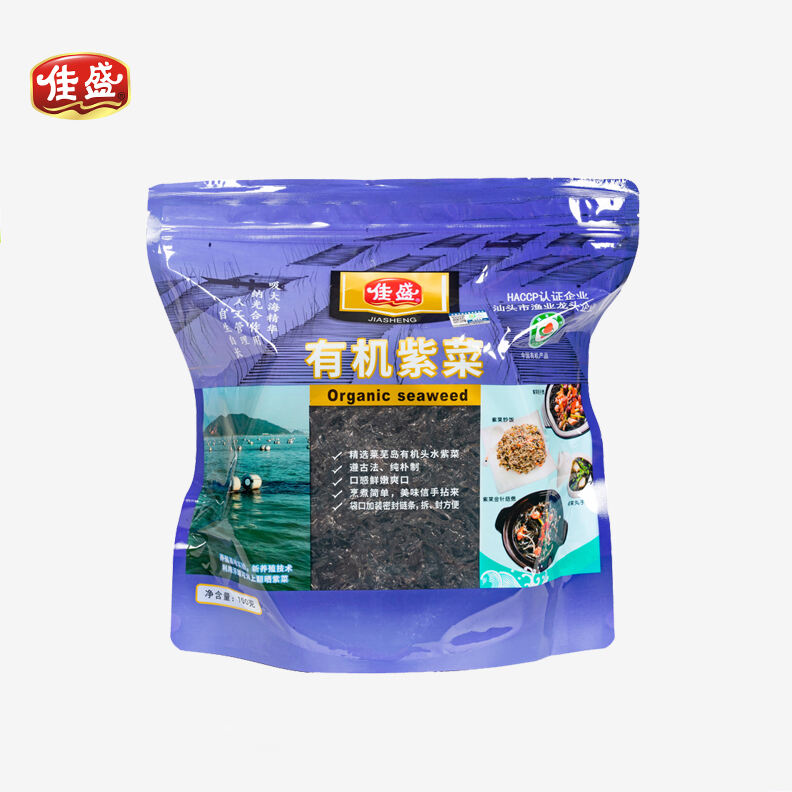Jan 07,2025
Algele au apărut ca un superaliment, oferind numeroase beneficii pentru sănătate și îmbunătățind experiențele culinare. Odată cu popularitatea în creștere a produselor organice, mulți consumatori se întreabă despre diferențele dintre algele organice și cele neorganice. În acest ghid cuprinzător, vom explora aceste diferențe, vom oferi informații despre cum să identificăm algele organice și vom prezenta câteva opțiuni fantastice de alge organice disponibile pe piață.
Algele organice se referă la algele care sunt cultivate sau recoltate în conformitate cu principiile agriculturii organice. Aceste principii previn utilizarea îngrășămintelor sintetice, pesticidelor și a inputurilor chimice artificiale. În schimb, algele organice se bazează pe îngrășăminte și nutrienți derivați natural din mediul marin. Un punct cheie de reținut este accentul pe practicile durabile, unde locurile de cultivare trebuie să fie desemnate departe de poluare și alte contaminări dăunătoare.
Pe de altă parte, algele non-organice pot fi cultivate sau colectate cu utilizarea îngrășămintelor sintetice și a substanțelor chimice dăunătoare. Aceste practici pot duce la contaminare și pot reduce calitatea nutrițională și de mediu a produsului final. Algele non-organice pot fi, de asemenea, recoltate din ape mai poluate, compromițând puritatea acestora.
Metodele de cultivare disting semnificativ algele organice de cele neorganice. Algele organice sunt de obicei cultivate pe sfori în ape curate sau colectate prin practici de recoltare sălbatică sustenabilă, care respectă biodiversitatea marină. În contrast, algele neorganice pot fi cultivate fără astfel de considerații ecologice riguroase, rezultând în posibile impacturi negative asupra mediului.
Algele organice folosesc fertilizatori naturali din ocean și orice nutrienți disponibili în mediul lor de creștere. Absența inputurilor sintetice înseamnă că algele organice păstrează niveluri mai ridicate de nutrienți, inclusiv vitamine, minerale și fibre dietetice. Această abordare holistică nu doar că îmbunătățește beneficiile pentru sănătate, dar este și ideală pentru ecosistem.
O altă diferență esențială constă în standardele de procesare. Algele marine organice trebuie să treacă prin procese stricte de certificare pentru a asigura calitatea și autenticitatea. De exemplu, Soil Association din Marea Britanie efectuează inspecții regulate pentru a menține aceste standarde. Algele marine non-organice, între timp, pot să nu fie supuse acestor reglementări riguroase, ceea ce poate afecta calitatea lor.
Impactul asupra mediului al algelor marine organice este notabil mai favorabil decât cel al omologului lor non-organic. Practicile de recoltare sustenabilă promovează biodiversitatea marină, protejează ecosistemele locale și ajută la prevenirea degradării habitatelor marine. Practicile non-organice pot introduce poluanți, contribuind la dezechilibrul ecologic și dăunând vieții marine.
Când cumpărați alge marine, verificați etichetele de certificare care indică statutul organic. Fiți atenți la certificări precum cele de la Soil Association sau USDA Organic. Aceste marcaje vă asigură că produsul a fost inspectat temeinic și respectă standarde specifice de agricultură organică.
De obicei, algele marine organice prezintă o culoare mai bogată și mai vibrantă și un aspect mai proaspăt comparativ cu varietățile non-organice. Metodele de recoltare și procesare utilizate mențin atributele naturale ale algelor fără utilizarea conservanților sau a coloranților artificiali.
Algele marine organice oferă adesea arome mai profunde și mai complexe comparativ cu alternativele non-organice. Condițiile de creștere curate și naturale contribuie la gustul său, făcându-l un ingredient delicios pentru creativitatea culinară. Consumatorii raportează adesea că algele marine organice îmbunătățesc experiența umami în preparate.
Algele marine organice sunt bogate în vitamine și minerale esențiale, inclusiv iod, fier, calciu și vitamina K. Gama de nutrienți găsită în varietățile organice susține diverse aspecte ale sănătății – de la promovarea funcției tiroidiene până la îmbunătățirea sănătății intestinale.
Alegerea algelor marine organice nu doar că beneficiază sănătatea personală, ci susține și practicile agricole durabile. Prin selectarea opțiunilor organice, consumatorii ajută la protejarea ecosistemelor marine și la promovarea biodiversității.
Cu aromele și texturile sale vibrante, alga marină organică poate ridica experiențele culinare. Fie că este folosită în supe, salate sau ca condiment pentru diverse preparate, alga marină organică îmbunătățește profilurile de gust cu bunătatea sa naturală.
Laver este un tip de alge roșii, care prosperă fără îngrășăminte sau pesticide, oferind alge marine proaspete și crocante, bogate în vitamine. Ideal pentru supe, prăjit și diverse preparate, aceste alge sunt de asemenea foarte curate, deși se recomandă o spălare ușoară înainte de gătire.
Acest pachet mai mic menține aceeași calitate ca varianta de 50g, perfect ca dimensiune de probă pentru cei care sunt noi în utilizarea algelor în rețetele lor.

Un format de cantitate mai mare care este ideal pentru fanii dedicați ai algelor, acest produs se mândrește de asemenea cu aceeași calitate premium și profil de aromă ca și omologii săi mai mici.
Principala diferență constă în practicile de cultivare și inputurile utilizate. Algele organice sunt cultivate fără îngrășăminte sau pesticide sintetice, promovând sustenabilitatea mediului și o valoare nutrițională mai mare.
Căutați etichete de certificare de la certificatori organici de renume, cum ar fi Soil Association sau USDA Organic.
Algele organice sunt bogate în nutrienți precum iod, fier, vitamine și fibre dietetice, susținând funcția tiroidiană, sănătatea intestinală și bunăstarea generală.
Prin alegerea algelor organice, consumatorii susțin practici de recoltare durabile care protejează biodiversitatea marină și reduc poluarea.
În concluzie, alegerea între algele organice și cele neorganice poate afecta semnificativ atât sănătatea personală, cât și mediul. Înțelegerea acestor distincții împuternicește consumatorii să facă alegeri informate, promovând nu doar bunăstarea lor, ci și sănătatea oceanelor noastre. Așadar, data viitoare când vă răsfățați cu acest aliment gustos și bogat în nutrienți, luați în considerare alegerea organică pentru un viitor mai durabil.